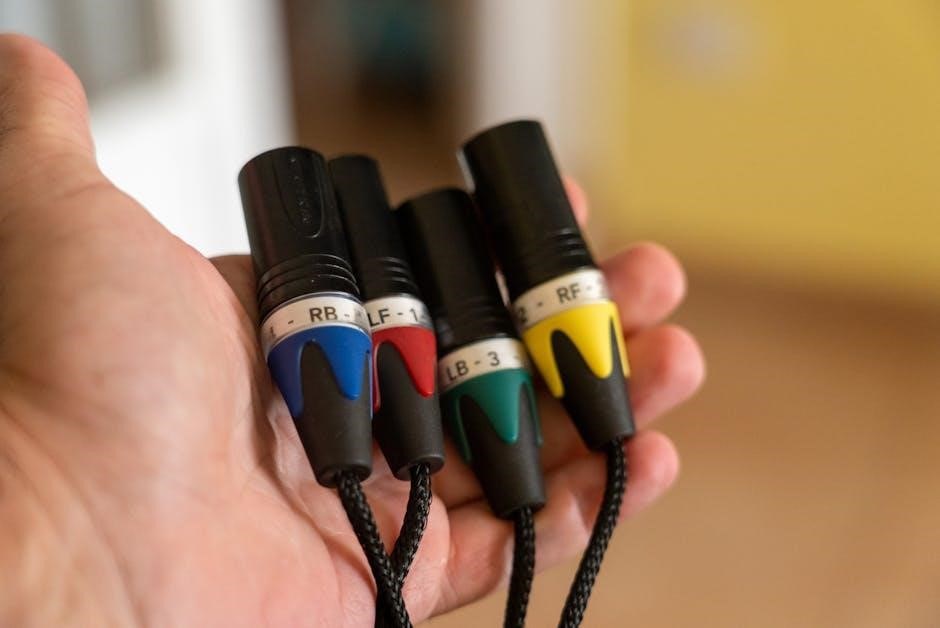Executive Summary
The coffee shop business plan outlines objectives to become the best new coffee bar, targeting students, office workers, and seniors near universities and offices, aiming for quick profitability with high-quality products and a welcoming environment.
Overview of the Coffee Shop Business
A coffee shop business plan is a detailed roadmap outlining the strategy for launching and managing a successful coffee shop. It covers key aspects such as target market, financial projections, and operational requirements. The plan helps entrepreneurs understand startup costs, equipment needs, and location selection. By focusing on high-quality products and a welcoming environment, coffee shops aim to attract diverse customer segments, including students, office workers, and seniors. A well-structured plan ensures clarity and confidence in achieving business goals, whether for an independent shop or a franchise.
Mission and Vision Statements
The mission of the coffee shop is to create a welcoming space offering high-quality coffee, artisanal pastries, and a community-focused environment. It aims to provide exceptional customer experiences through superior products and outstanding service. The vision is to become a recognized leader in the coffee industry, fostering connections and satisfaction in every cup. By prioritizing quality, sustainability, and customer-centric values, the shop strives to build lasting relationships with its community and contribute to the local culture, ensuring long-term success and growth.
Objectives and Goals
The primary objective is to establish the coffee shop as a premier destination for high-quality coffee and pastries, achieving profitability within the first month. Key goals include creating a welcoming environment, building a loyal customer base, and offering exceptional products. The shop aims to differentiate itself through superior taste, sustainable practices, and outstanding customer service. Long-term goals include expanding the customer base, exploring new market opportunities, and maintaining consistent growth. By focusing on quality and community engagement, the coffee shop strives to become a beloved local fixture and a model for excellence in the industry.
Market Analysis
The coffee shop will target students, office workers, and seniors near universities and offices, addressing a competitive market where 90% of cafes fail within five years.
Industry Overview
The coffee industry is growing rapidly, driven by increasing demand for specialty coffee. Major chains dominate the market, but independent shops thrive by offering unique experiences. The target market includes students, office workers, and seniors seeking convenience and quality. With 90% of cafes failing within five years, understanding the competitive landscape is crucial. Success depends on differentiation through high-quality products, strategic locations, and strong branding. The industry’s resilience and consumer trends favor shops that adapt to evolving preferences, such as sustainability and premium offerings.
Target Market and Customer Segmentation
The target market includes students, office workers, and seniors, focusing on convenience, quality, and affordability. Students seek affordable, study-friendly environments, while office workers prioritize quick service and premium coffee. Seniors prefer a welcoming, comfortable space. The shop will cater to these segments with tailored offerings, creating a community-focused atmosphere. Understanding these groups’ preferences is crucial for differentiation in a competitive market, ensuring the shop meets diverse needs effectively while building loyalty and attracting repeat customers.
Competitive Analysis
The coffee shop market is highly competitive, with numerous cafes in urban areas. However, there is a noticeable gap in quality and customer experience. While many cafes prioritize convenience, few focus on premium products and a welcoming atmosphere. By using high-quality equipment and expertly trained staff, the shop will differentiate itself. The emphasis on a community-focused environment and superior customer service will attract loyal customers. Understanding competitors’ strengths and weaknesses is key to positioning the shop as a unique, high-value destination in a crowded market.
Market Trends and Growth Opportunities
The demand for specialty coffee and artisanal beverages is rising, driven by younger demographics and a growing appreciation for quality. Sustainability and ethical sourcing are increasingly important to consumers. The third-wave coffee movement presents opportunities to differentiate by offering unique, high-quality products. Additionally, the trend toward community-focused spaces allows coffee shops to become hubs for social interaction and remote work. By leveraging these trends, the shop can attract a loyal customer base and capitalize on growth opportunities in a competitive market.
Business Model
The business model focuses on revenue streams from coffee, food, and specialty drinks, with a pricing strategy balancing affordability and quality, emphasizing customer experience and loyalty.
Revenue Streams
The coffee shop will generate revenue through the sale of high-quality coffee, specialty beverages, and food items. Additional streams include catering services, merchandise sales, and loyalty program offerings. The shop will also offer seasonal products and subscriptions to increase recurring revenue. A strong emphasis will be placed on upselling and bundling items to maximize transaction value. Online ordering and delivery services will further diversify revenue sources, ensuring a steady income flow. These strategies aim to create a sustainable and profitable business model.
Pricing Strategy
The coffee shop will implement a competitive pricing strategy to attract a broad customer base. Prices will be set slightly below market rates for standard beverages while premium offerings will be priced higher to reflect quality. Discounts will be offered for loyalty program members and bulk purchases to encourage repeat business. Seasonal items will feature dynamic pricing to capitalize on demand. Transparent pricing will be clearly displayed to avoid customer confusion, ensuring a fair and value-driven approach that aligns with customer expectations and supports long-term profitability.
Customer Value Proposition
The coffee shop offers a welcoming space with high-quality coffee, artisanal pastries, and a community-focused environment. By sourcing ethically and using expert techniques, we ensure exceptional taste and sustainability. Our friendly, knowledgeable staff provide personalized service, enhancing the customer experience. A cozy ambiance with comfortable seating invites relaxation and productivity, making us a preferred destination for socializing, working, or unwinding. We prioritize customer satisfaction, fostering loyalty through consistent quality, unique offerings, and a commitment to community engagement, ensuring every visit feels special and rewarding.
Menu and Product Offerings
Our menu features high-quality coffee, artisanal pastries, and specialty beverages, with seasonal items to attract diverse tastes and preferences, ensuring a unique and satisfying customer experience.
Coffee and Beverage Options
Our coffee shop offers a diverse selection of specialty coffee drinks, including espresso, cappuccino, latte, and macchiato, made with high-quality beans. We also serve single-origin pour-overs, cold brew, and flavored lattes. Additionally, we provide a variety of teas, hot chocolate, and seasonal beverages like pumpkin spice latte and peppermint mocha. Our menu includes dairy-free and vegan options to cater to all preferences. We use commercial-grade equipment to ensure consistency and quality, presenting each drink with precision and care to enhance the customer experience and build loyalty.
Food and Pastry Offerings
Our coffee shop offers a variety of high-quality food and pastry options to complement our beverages. The menu includes freshly baked croissants, muffins, scones, and artisanal bread. We also serve light bites such as sandwiches, salads, and quiche. Seasonal offerings like gingerbread cookies and fruit tarts add variety throughout the year. All items are made with locally sourced ingredients to ensure freshness and flavor. Vegan and gluten-free options are available to cater to diverse dietary needs. Our pastries and food are presented attractively to enhance the overall customer experience and create a welcoming atmosphere.
Specialty and Seasonal Items
Our coffee shop features specialty drinks like matcha lattes and seasonal offerings such as gingerbread lattes during winter. Seasonal pastries, including fruit tarts and holiday cookies, are introduced quarterly. Limited-time items, like pumpkin spice muffins in fall, create buzz and attract repeat customers. Collaborations with local bakeries ensure unique and fresh offerings. These specialty and seasonal items differentiate us from competitors, appealing to both loyal customers and newcomers seeking unique experiences. Quality and presentation are prioritized to enhance customer satisfaction and drive sales during peak seasons.
Operations Plan
The coffee shop will operate efficiently with commercial-grade equipment, trained staff, and a reliable supply chain. Location, maintenance, and quality control ensure seamless daily operations and customer satisfaction.
Location and Premises
Selecting a prime location is crucial for the coffee shop’s success. The premises should be visible, accessible, and near high-traffic areas like universities or offices. The space will be designed to create a welcoming atmosphere, with a dining area, coffee bar, restrooms, and storage. Equipment and layout will ensure efficient operations, while the location’s proximity to target markets will drive foot traffic. A central spot with ample seating and amenities will enhance customer experience and support long-term growth.
Equipment and Supplies
Investing in high-quality, commercial-grade equipment is essential for a coffee shop. This includes espresso machines from trusted brands like La Marzocco or Nuova Simonelli, grinders, brewers, and point-of-sale systems. Durable equipment ensures consistent performance and longevity. Supplies such as specialty coffee beans, milks, syrups, and pastries must be sourced from reliable vendors to maintain quality. Proper maintenance routines and staff training on equipment operation are critical to avoid downtime and customer dissatisfaction. The right equipment and supplies enhance efficiency, product quality, and customer satisfaction, forming the backbone of a successful coffee shop operation.
Staffing and Training
Hiring experienced baristas and staff is crucial for a coffee shop’s success. Comprehensive training programs should cover coffee preparation, customer service, and equipment operation. Investing in staff development ensures consistency and quality. Many owners recommend gaining management experience in another coffee shop before starting your own to understand operational challenges. Proper training prevents mistakes, enhances customer satisfaction, and builds a positive reputation. Without adequate training, even the best equipment and products can fail to impress, leading to business setbacks and financial losses.
Supply Chain Management
Effective supply chain management ensures consistent quality and availability of ingredients. Sourcing high-quality coffee beans, pastries, and dairy products from reliable suppliers is essential. Building relationships with local suppliers can reduce costs and environmental impact. Regular inventory checks and efficient ordering systems prevent stock shortages or excess. Investing in technology, such as inventory management software, streamlines operations. A well-managed supply chain supports customer satisfaction and business scalability, ensuring the coffee shop maintains its standards and adapts to growth demands without compromising on product quality or operational efficiency.
Marketing and Sales Strategy
A strong brand identity and digital presence drive customer engagement. Utilize social media, email marketing, and loyalty programs to attract and retain customers, ensuring consistent growth and sales.
Branding and Positioning
Effective branding and positioning are crucial for differentiation. A strong brand identity, including a memorable logo and consistent visual style, helps build customer loyalty. Positioning the coffee shop as a premium destination for quality-conscious consumers ensures a competitive edge. Emphasizing sustainability and ethical sourcing can attract environmentally aware customers. The choice of equipment, such as professional espresso machines, reinforces credibility and expertise; A welcoming atmosphere and exceptional customer service further enhance the brand image, making the coffee shop a preferred choice in a crowded market.
Marketing Channels
Effective marketing channels are essential for reaching the target audience. Social media platforms like Instagram and Facebook can showcase products and engage customers. Partnerships with local businesses, universities, and offices can drive foot traffic. Email marketing campaigns and loyalty programs help retain customers. Influencer collaborations and community events enhance brand visibility. A strong online presence, including a website and delivery apps, expands reach. Regular promotions and seasonal offers keep the customer base engaged and attract new patrons, ensuring consistent growth and brand awareness in a competitive market.
Promotional Activities
Promotional activities will play a key role in attracting and retaining customers. Discounts, loyalty rewards, and limited-time offers will encourage repeat visits. Seasonal promotions, such as holiday-themed drinks, will create buzz and drive sales. Hosting events like live music nights or coffee-tasting sessions will foster community engagement; Social media contests and referral programs will expand reach and build brand loyalty. These activities aim to create a vibrant, customer-centric experience that sets the coffee shop apart from competitors and ensures long-term growth and customer satisfaction.
Customer Loyalty Programs
A robust loyalty program will be implemented to reward repeat customers and foster long-term retention. Customers will earn points for every purchase, redeemable for discounts or free items. Exclusive offers, such as birthday rewards and early access to new products, will enhance engagement. A referral program will incentivize customers to bring in friends, further expanding the customer base. Digital loyalty cards and app-based rewards will streamline the process, ensuring convenience and encouraging frequent visits. These initiatives aim to build a loyal customer community, driving repeat business and increasing customer lifetime value.
Financial Plan
The financial plan outlines startup costs, revenue projections, and expense forecasts, ensuring sustainability. It details funding requirements and strategies to achieve profitability within the first year of operation.
Startup Costs
Startup costs for a coffee shop include equipment, lease, inventory, and initial operational expenses. Initial investments can range widely, but planning for double the estimated budget is advised. Commercial-grade equipment is crucial for durability and customer perception, with costs for espresso machines and grinders being significant. Additional expenses include renovations, permits, and initial staffing. Proper financial planning ensures sustainability, avoiding common pitfalls like underestimating costs. Detailed budgeting and securing adequate funding are essential to cover all initial expenditures and ensure smooth operations from day one.
Revenue Projections
Revenue projections for a coffee shop are based on sales forecasts, considering average transaction values and daily customer traffic. Targeting students, office workers, and seniors, the shop aims to generate steady income through coffee, pastries, and specialty drinks. Initial monthly sales are projected to grow steadily, with profitability expected within the first year. A detailed business plan outlines financial goals, ensuring realistic projections align with market demand and operational efficiency. Accurate revenue forecasting is crucial for securing investments and achieving long-term sustainability in a competitive market.
Expense Projections
Expense projections for a coffee shop include initial startup costs, such as equipment, rent, and inventory, as well as ongoing operational expenses like labor, utilities, and supplies. These projections are critical for creating a detailed financial plan, ensuring the business remains sustainable. By outlining expected expenditures, the shop can allocate resources effectively and prepare for potential financial challenges. Accurate expense forecasting helps in securing funding and maintaining profitability, ensuring the coffee shop operates smoothly and achieves its long-term goals in a competitive market environment.
Funding Requirements
The coffee shop business plan requires significant upfront investment to cover startup costs, including equipment, lease, and initial inventory. Estimated expenses for the first three years should be carefully planned to ensure sustainability. Funding can be sourced through loans, investors, or personal savings. A detailed financial plan is essential to secure investments, outlining projected revenue and expenses. This ensures the business can operate smoothly and achieve profitability. Proper funding management is crucial for long-term success in the competitive coffee shop industry.
Risk Management
A comprehensive risk management plan identifies potential market, operational, and financial risks, outlining mitigation strategies to ensure business sustainability and customer satisfaction.
Market Risks
Market risks include intense competition from established cafes, shifting consumer preferences, and economic downturns impacting disposable income. Rising costs of coffee beans and supplies pose additional challenges. To mitigate these risks, the business must focus on a unique value proposition, adapt to market trends, and maintain high-quality standards. Conducting thorough market research and understanding customer needs are crucial to staying competitive. Diversifying offerings and building strong customer relationships can help sustain the business during economic fluctuations. A flexible pricing strategy and continuous monitoring of market dynamics are essential for long-term success.
Operational Risks
Operational risks include equipment failure, staffing challenges, and supply chain disruptions. Commercial-grade equipment is crucial to avoid breakdowns and maintain customer trust. Inadequate training can lead to poor service quality. Location accessibility and foot traffic are also critical factors. Effective staff management and reliable suppliers are essential to mitigate these risks and ensure smooth operations.
Financial Risks
Financial risks include high startup costs, equipment expenses, and initial operational losses. Many cafes fail within five years due to insufficient funding or poor financial planning. A solid business plan is crucial to outline funding sources, expense projections, and revenue forecasts. Without proper capital allocation, the risk of financial instability increases. Additionally, market saturation and competition can impact profitability. Ensuring a detailed financial plan, including contingency funds, is essential to mitigate these risks and achieve long-term sustainability in the competitive coffee shop industry.
Mitigation Strategies
To address financial and operational risks, a robust business plan is essential, detailing startup costs, revenue projections, and contingency funds. Conducting thorough market analysis ensures understanding competition and demand. Diversifying revenue streams, such as offering subscriptions or catering services, can reduce reliance on in-store sales. Investing in high-quality, maintainable equipment minimizes downtime and enhances customer perception. Effective staff training and operational efficiency also mitigate risks. Regular financial reviews and adaptive strategies help navigate challenges, ensuring long-term sustainability and profitability in the competitive coffee shop industry.
Growth and Expansion
Strategies include expanding locations, diversifying product offerings, and exploring new markets to increase brand presence and revenue streams, ensuring sustainable growth and long-term success.
Short-Term Goals
Establish a strong presence in the local market within the first year by attracting a loyal customer base. Achieve profitability within six months of opening. Focus on refining menu offerings, ensuring high-quality products, and delivering exceptional customer service. Build a reputation for excellence through consistent execution and community engagement. Implement effective marketing strategies to drive foot traffic and sales. Develop a loyalty program to encourage repeat business and gather customer feedback for continuous improvement. Ensure operational efficiency and maintain high standards of cleanliness and safety in the shop.
Long-Term Goals
Aim to expand the coffee shop to multiple locations within five years, establishing a strong brand presence. Focus on building long-term customer relationships and loyalty through consistent quality and personalized experiences. Explore franchising opportunities to scale the business sustainably. Invest in employee development to create a skilled and motivated team. Continuously innovate menu offerings and operational processes to stay ahead of market trends. Achieve recognition as a leader in the coffee shop industry by maintaining high standards and fostering community connections. Ensure long-term profitability and growth while upholding the brand’s core values.
Strategies for Scaling the Business
Explore franchising opportunities to expand the coffee shop brand into new markets. Open additional locations in high-traffic areas, ensuring consistency in quality and customer experience. Diversify product offerings to attract a broader customer base; Invest in technology, such as mobile ordering and delivery services, to enhance operational efficiency and customer convenience. Build strategic partnerships with suppliers to secure better pricing and improve supply chain management. Continuously monitor market trends and adapt business strategies to maintain competitiveness. Focus on building a strong brand identity to differentiate from competitors and attract loyal customers.
The coffee shop business plan serves as a roadmap, guiding decisions and strategies to ensure long-term success and profitability in the competitive market.
A well-structured coffee shop business plan is essential for success, outlining objectives, target markets, and financial strategies. It emphasizes the importance of quality equipment, consistent customer experiences, and thorough market analysis. The plan should include detailed financial projections, startup costs, and revenue goals, while addressing potential risks and mitigation strategies. By focusing on a unique value proposition and a clear operational framework, the plan guides decision-making to establish a profitable and sustainable coffee shop business in a competitive market.
Final Statement
A well-crafted coffee shop business plan is crucial for success, guiding entrepreneurs through market analysis, financial planning, and operational strategies. By prioritizing quality equipment, consistent customer experiences, and a clear vision, coffee shop owners can build a loyal customer base and achieve long-term profitability. Securing funding, understanding risks, and adapting to market trends are essential steps to ensure sustainability. With dedication and a strategic approach, a coffee shop can become a thriving business, offering more than just coffee—it fosters community and creates lasting memories for its customers.





























